Sharpless epoxidation converts a prochiral allylic alcohol into the corresponding chiral epoxide with > 90% enantiomeric excess[1],[2]. Here is the first step in trying to explain how this magic is achieved.
The scheme above shows how (achiral) prop-2-enol is converted using the asymmetric catalyst (R,R)-diethyl tartrate and t-butyl hydroperoxide as oxidant into the (S)-chiral epoxide. The first step is to try to construct a simple model for the reaction, and in this post I will start by using one titanium as the core of the stage on which these actors will perform. This is the mononuclear model†. One can simply envisage that a molecule of tartrate displaces two iPrOH molecules from Ti(OiPr)4 in an ester exchange to form a Ti(OiPr)2(tartrate) complex. The remaining two iso-propanols are then replaced by one molecule each of prop-2-enol and tBu-OOH. Now we have the species Ti(OOtBu)(O-CH2CH=CH2)(tartrate) as the starting point from which a transition state for oxygen transfer to the alkene to form the (S) epoxide (for R,R tartrate) can be constructed (ωB97XD/6-311G(d,p)/SCRF=dichloromethane model).
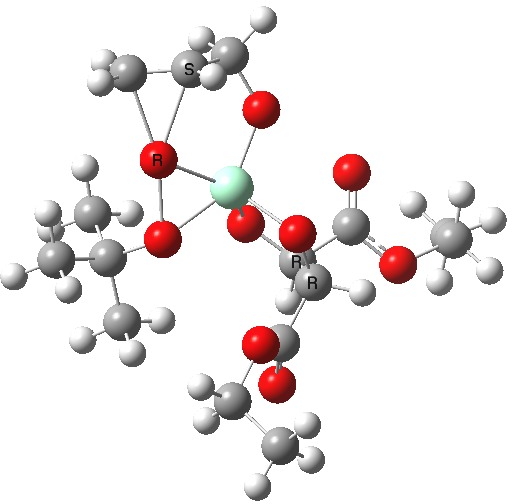 Mononuclear TS for S-epoxide. Click for 3D. |
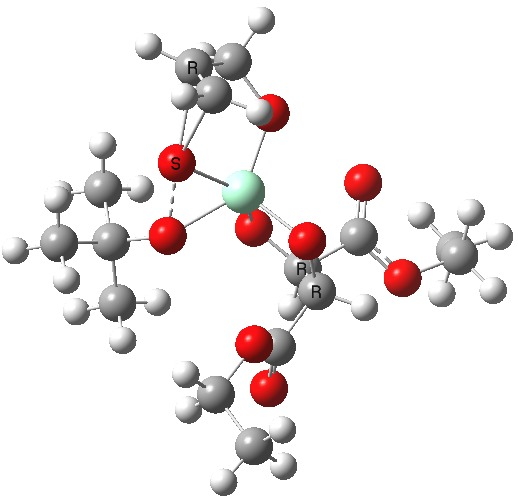 Mononuclear TS for R-epoxide. Click for 3D. |
| IRC for mononuclear model showing oxygen atom transfer | |
|---|---|
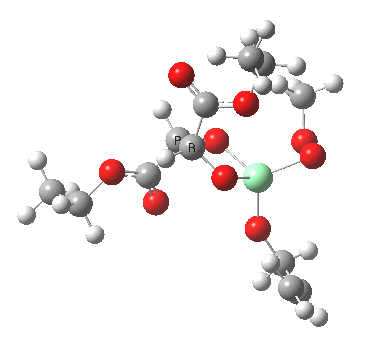 |
|
The transition state leading to (S) epoxide emerges as 0.86 kcal/mol higher in ΔG‡ than the (R), contrary to the experimental result where (S) is formed with high specificity[1]. Inspecting the model, it is clear that the allylic alcohol substrate sits in a very open pocket un-encumbered by any nearby groups (bottom right in the animation above) and so the lack of π-facial selectivity is perhaps not surprising.
To elaborate the model, I will turn to a crystal structure determined for a Ti complex bearing a t-butyl peroxy group[3], showing it to be a binuclear complex¶ (magenta arrows indicate the peroxy groups) with bridging oxygen atoms.‡
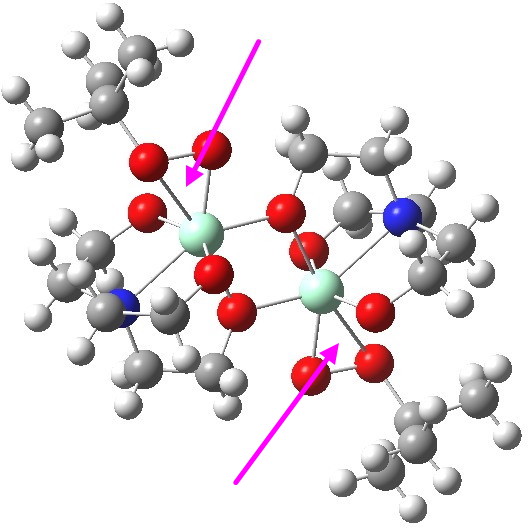
ZUKJIY. Click for 3D
In the follow-up post, we will see whether these binuclear models can do better at explaining the enantioselectivity of the Sharpless reaction.
† See this post for an example of such “single-site” catalysis using Mg or this article for an example using silver[4].
¶A binuclear Zn catalyst with similar oxy-bridges is used to co-polymerise epoxides themselves with carbon dioxide[5]. Many such binuclear complexes are known.
‡ The other element for which a number of examples of such t-butyl peroxy bonding are known is oddly enough, lithium.[6]
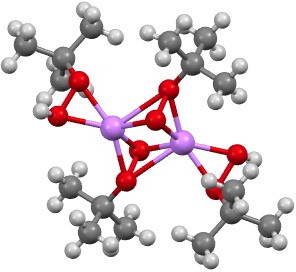
MUKVAQ. Click for 3D.
Postscript: Two lower energy conformations for the S and R transition states have been found, the latter being 1.6 kcal/mol lower in free energy.
| S | R |
|---|---|
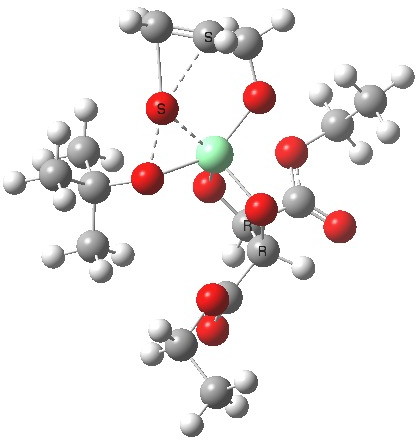 |
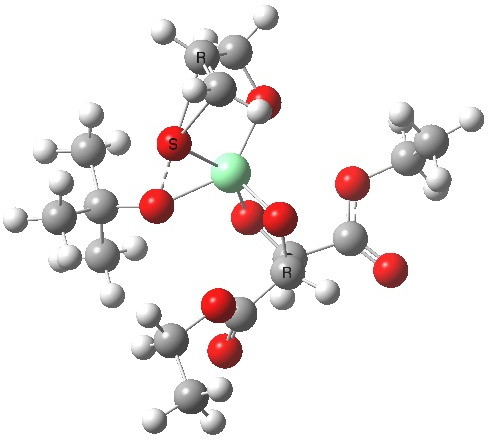 |
References
- J.M. Klunder, S.Y. Ko, and K.B. Sharpless, "Asymmetric epoxidation of allyl alcohol: efficient routes to homochiral .beta.-adrenergic blocking agents", The Journal of Organic Chemistry, vol. 51, pp. 3710-3712, 1986. https://doi.org/10.1021/jo00369a032
- R.M. Hanson, and K.B. Sharpless, "Procedure for the catalytic asymmetric epoxidation of allylic alcohols in the presence of molecular sieves", The Journal of Organic Chemistry, vol. 51, pp. 1922-1925, 1986. https://doi.org/10.1021/jo00360a058
- G. Boche, K. Möbus, K. Harms, and M. Marsch, "[((η<sup>2</sup>-<i>tert</i>-Butylperoxo)titanatrane)<sub>2</sub>· 3 Dichloromethane]: X-ray Crystal Structure and Oxidation Reactions", Journal of the American Chemical Society, vol. 118, pp. 2770-2771, 1996. https://doi.org/10.1021/ja954308f
- J.L. Arbour, H.S. Rzepa, J. Contreras‐García, L.A. Adrio, E.M. Barreiro, and K.K.(. Hii, "Silver‐Catalysed Enantioselective Addition of OH and NH Bonds to Allenes: A New Model for Stereoselectivity Based on Noncovalent Interactions", Chemistry – A European Journal, vol. 18, pp. 11317-11324, 2012. https://doi.org/10.1002/chem.201200547
- A. Buchard, F. Jutz, M.R. Kember, A.J.P. White, H.S. Rzepa, and C.K. Williams, "Experimental and Computational Investigation of the Mechanism of Carbon Dioxide/Cyclohexene Oxide Copolymerization Using a Dizinc Catalyst", Macromolecules, vol. 45, pp. 6781-6795, 2012. https://doi.org/10.1021/ma300803b
- W. Uhl, M. Reza Halvagar, and M. Claesener, "Reducing GaH and GaC Bonds in Close Proximity to Oxidizing Peroxo Groups: Conflicting Properties in Single Molecules", Chemistry – A European Journal, vol. 15, pp. 11298-11306, 2009. https://doi.org/10.1002/chem.200900746
Tags: animation, asymmetric epoxidation, catalysis, Enantioselective, free energy, lower energy conformations, Reaction Mechanism, Tutorial material
[…] Chemistry with a twist « Why is the Sharpless epoxidation enantioselective? Part 1: a simple model. […]